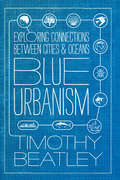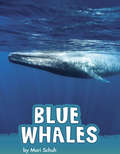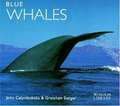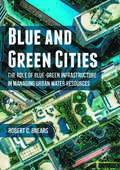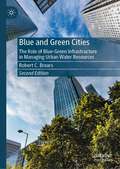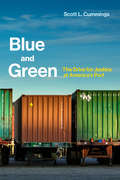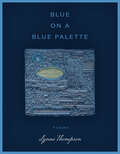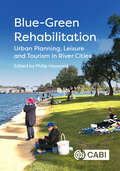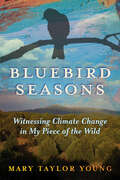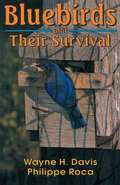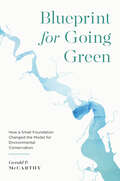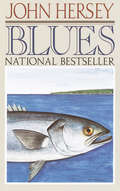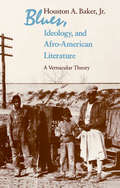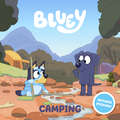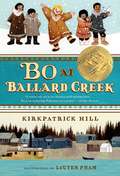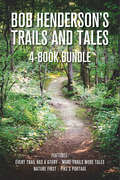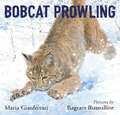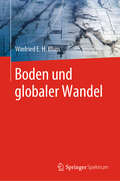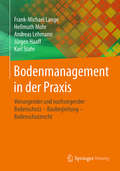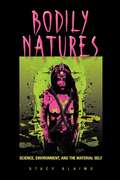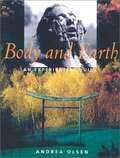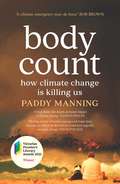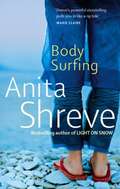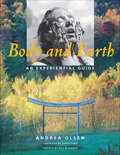- Table View
- List View
Blue Urbanism: Exploring Connections Between Cities and Oceans
by Timothy BeatleyWhat would it mean to live in cities designed to foster feelings of connectedness to the ocean? As coastal cities begin planning for climate change and rising sea levels, author Timothy Beatley sees opportunities for rethinking the relationship between urban development and the ocean. Modern society is more dependent upon ocean resources than people are commonly aware of--from oil and gas extraction to wind energy, to the vast amounts of fish harvested globally, to medicinal compounds derived from sea creatures, and more. In Blue Urbanism, Beatley argues that, given all we've gained from the sea, city policies, plans, and daily urban life should acknowledge and support a healthy ocean environment. The book explores issues ranging from urban design and land use, to resource extraction and renewable energy, to educating urbanites about the wonders of marine life. Chapters delve into topics like the emerging practices of "community supported fisheries" and aquaponics, incentives for increasing use of wind and tidal energy as renewable options to oil and gas extraction that damages ocean life, and how the shipping industry is becoming more "green. " Additionally, urban citizens, Beatley explains, have many opportunities to interact meaningfully with the ocean, from beach cleanups to helping scientists gather data. Ultimately, he explains that we must create a culture of "ocean literacy" using a variety of approaches, from building design and art installations that draw inspiration from marine forms, to encouraging citizen volunteerism related to oceans, to city-sponsored research, and support for new laws that protect marine health. Equal parts inspiration and practical advice for urban planners, ocean activists, and policymakers, Blue Urbanism offers a comprehensive look at the challenges and great potential for urban areas to integrate ocean health into their policy and planning goals.
Blue Whales (Animals)
by Mari SchuhBlue whales are the largest animals to ever have lived on Earth! But they are often hidden from human eyes deep beneath ocean waves. Find out their secrets and get all the facts about these majestic water mammals.
Blue Whales (Worldlife Library)
by John Calambokidis Gretchen SteigerFrom the Book jacket: Blue Whales are the largest animals ever to have lived on earth - even larger than any of the known dinosaurs. While they are found in all the oceans of the world, they are also an endangered species. Let John Calambokidis and Gretchen Steiger introduce you to these massive mammals. They examine the habitats, behaviors, and movements of blue whales, and describe efforts that are being made to protect these rare giants worldwide. Discover the world's animals in the WorldLife Library from Voyageur Press. This highly acclaimed series brings you the latest research from leading naturalists, along with stunning color photographs of your favorite animals.
Blue and Green Cities: The Role Of Blue-green Infrastructure In Managing Urban Water Resources
by Robert C. BrearsThis book offers new research on urban policy innovations that promote the application of blue-green infrastructure in managing water resources sustainably. The author argues that urban water managers have traditionally relied on grey infrastructural solutions to mitigate risks with numerous economic and environmental consequences. Brears explores the role urban water managers have in implementing blue-green infrastructure to reduce ecological damage and mitigate risk. The case studies in this book illustrate how cities, of differing climates, lifestyles and income-levels, have implemented policy innovations that promote the application of blue-green infrastructure in managing water, wastewater and stormwater sustainably to reduce environmental degradation and enhance resilience to climate change. This new research on urban policy innovations that promote the application of blue-green infrastructure in managing water resources sustainably will be of interest to those working on water conservation and policy.
Blue and Green Cities: The Role of Blue-Green Infrastructure in Managing Urban Water Resources
by Robert C. BrearsA completely revised and updated new edition of this successful book focused on urban policy innovations that promote the application of blue-green infrastructure in managing water resources sustainably. Since the first edition published, nature-based solutions in general and blue-green infrastructure, in particular, have become a more recognised solution to various societal challenges, including mitigating climatic extremes in cities while restoring the natural environment and enhancing biodiversity. This new edition provides updated research on urban policy innovations that promote the application of BGI in managing water resources sustainably. In particular, the book contains case studies that illustrate how cities of differing climates, lifestyles and income levels have implemented policy innovations that promote the application of BGI in managing water, wastewater and stormwater sustainably to enhance resilience to climate change and reduce environmental degradation. The seven case studies are leading cities that have implemented various fiscal and non-fiscal policy tools to encourage the implementation of BGI on both public and private property to reduce stormwater runoff volumes, enhance the health of waterways, enhance resilience to climate change and meet regulatory requirements.
Blue and Green: The Drive for Justice at America's Port (Urban and Industrial Environments)
by Scott L. CummingsHow an alliance of the labor and environmental movements used law as a tool to clean up the trucking industry at the nation's largest port. In Blue and Green, Scott Cummings examines a campaign by the labor and environmental movements to transform trucking at America's largest port in Los Angeles. Tracing the history of struggle in an industry at the epicenter of the global supply chain, Cummings shows how an unprecedented “blue-green” alliance mobilized to improve working conditions for low-income drivers and air quality in nearby communities. The campaign for “clean trucks,” Cummings argues, teaches much about how social movements can use law to challenge inequality in a global era.Cummings shows how federal deregulation created interrelated economic and environmental problems at the port and how the campaign fought back by mobilizing law at the local level. He documents three critical stages: initial success in passing landmark legislation requiring port trucking companies to convert trucks from dirty to clean and drivers from contractors to employees with full labor rights; campaign decline after industry litigation blocked employee conversion; and campaign resurgence through an innovative legal approach to driver misclassification that realized a central labor movement goal—unionizing port truckers.Appraising the campaign, Cummings analyzes the tradeoffs of using alternative legal frameworks to promote labor organizing, and explores lessons for building movements to regulate low-wage work in the “gig” economy. He shows how law can bind coalitions together and split them apart, and concludes that the fight for legal reform never ends, but rather takes different turns on the long road to justice.
Blue on a Blue Palette
by Lynne ThompsonLynne Thompson’s Blue on a Blue Palette reflects on the condition of women—their joys despite their histories, and their insistence on survival as issues of race, culture, pandemic, and climate threaten their livelihoods. The documentation of these personal odysseys—which vary stylistically from abecedarians to free verse to centos—replicate the many ways women travel through the stages of their lives, all negotiated on a palette encompassing various shades of blue. These poems demand your attention, your voice: “Say history. Claim. Say wild.”
Blue-Green Rehabilitation: Urban Planning, Leisure and Tourism in River Cities
by Philip HaywardIn recent decades there has been a burgeoning interest in the development of blue-green corridors: areas where waterways are complemented by adjoining green spaces and related paths and leisure facilities. Urban planners have increasingly favoured such zones as a means of refreshing inner-city spaces. In many cases, such projects have involved the rehabilitation of former industrial and/or otherwise polluted waterways and adjacent land. These newly configured blue-green spaces have benefitted residents and provided a substantial attraction to tourists through in- and on- the water options (e.g., swimming, kayaking, fishing, cruise boat transit etc.), waterside relaxation and a range of riverbank activities. The establishment of managed green spaces has also seen the return of a variety of native species to such areas and the re-presentation of former waterside industrial features as heritage artefacts has also added value and appeal to such corridors. The anthology comprises nine international case studies that illustrate examples of best practice and/or the problems that can arise from such rehabilitations, such as gentrification (forcing housing prices up and dispersing established communities) and de-industrialisation that leads to reduced livelihood opportunities. Individual studies in the volume analyse the dynamics of neglect and rehabilitation, contrasting stakeholder agendas, destination branding and regional-national orientations. Collectively, the volume comprises an important reference point for future blue-green rehabilitation projects and the conclusion offers an agenda for the development of just and sustainable blue-green initiatives.
Bluebird Seasons: Witnessing Climate Change in My Piece of the Wild
by Mary Taylor YoungIn this A Sand County Almanac for the twenty-first century, nature writer and zoologist Mary Taylor Young tells the story of the growing effects of climate change on her land in the pine-covered foothills of southern Colorado. Climate change wasn't yet on the public radar when Young and her husband bought their piece of the wild in 1995. They built a cabin and set up a trail of bluebird nest boxes, and Mary began a nature journal of her observations, delighting in the ceaseless dramas, joys, and tragedies that are the fabric of life in the wild. But changes greater than the seasonal cycles of nature became evident over time: increasing drought, trees killed by plagues of beetles, wildfires, catastrophic weather, bears entering hibernation later and thinner, the decline of some familiar birds, and the appearance of new species. Their journal of sightings over twenty-five bluebird seasons, she realized, was a record of climate change happening, not in an Indonesian rainforest or on an Antarctic ice sheet but in their own natural neighborhood. Using the journal as a chronicle of change, Young tells a story echoed in everyone's lives and backyards. But it's not time to despair, she writes. It's time to act. Young sees hope in the human ability to overcome great obstacles, in the energy and determination of young people, and in nature's resilience, which the bluebirds show season after season.
Bluebirds and Their Survival: and Their Survival
by Wayne H. Davis Philippe RocaBring more bluebirds into your life with this “lavishly illustrated [and] easy-to-read” how-to book (Manchester Enterprise).Bluebird expert Wayne H. Davis tells how to attract and care for this beautiful and gentle bird and offers solutions to the most common bluebird problems. Since bluebirds are almost entirely dependent on people for providing nesting sites, the book contains plans for erecting a structure that will attract bluebirds to a safe habitat. Instructions for building and maintaining a “bluebirds trail,” complete with drawings of various bluebirds houses and guards against predators, are also included. Davis shares his plans for his specially designed Kentucky Bluebird Box?a unique bird house attractive to the Eastern Bluebird but unsuitable for the bluebird’s rivals?as well a variety of other plans for using materials as inexpensive as milk cartons and scavenged pipes. A chapter by professional photographer Philippe Roca offers tips on photographing bluebirds. Whether you’re a beginning birder or an expert, Davis will help ensure your success in attracting and raising bluebirds.“To ensure the survival of bluebirds (a North American native threatened by sparrows and starlings), the authors instruct on how to build habitats, distribute winter feed, and foil enemies, both feathered and furred. Scientific research is cited to back the authors’ claims on the best diet, nesting locations, and shelters. Finally offered are photography lessons and specific birdhouse designs, from simple milk jugs to a sparrow-inhibiting nest box. Bird-watchers, earnest and casual, will benefit from this guide.” —Booklist
Blueprint for Going Green: How a Small Foundation Changed the Model for Environmental Conservation
by Gerald P. McCarthyHow one organization took on industrial pollution—and the lessons for our new century In 1977, one forward-thinking judge took an ecological disaster—the poisoning of the James River by Allied Chemical—and turned it into a great environmental-protection legacy. The $8 million payment made by Allied would go on to fund the game-changing Virginia Environmental Endowment.Blueprint for Going Green provides an insider&’s account of the remarkable results of this landmark ruling and the foundation it spawned. Over the following decades, the VEE helped to grow the fledgling environmental movement in Virginia into a powerful force for protecting the state&’s water quality and conserving its landscape. This inspiring story reveals how a small group can make a profound difference by engaging in public policy work, funding science to advance public policy, and helping to build a lasting and effective citizen-led environmental movement. Finalist for the Southern Environmental Law Center's Phillip D. Reed Environmental Writing Award
Blues
by John HerseyFrom the revered Pulitzer Prize winning journalist and writer, comes his National Bestseller on one of the world’s oldest and most popular activities, fishing. Presented in narrative form as a conversation between a Fisherman and the Stranger, Hersey draws upon his own experiences and passion as the fisherman reflects on the age old sport, offering his own insights and thoughts. From the depths of the ocean to the creatures near the shore, Hersey perfectly answers why fishing has been such an integral part of humanity. “Almost no one has answered “why fish?” better than Mr. Hersey . . . what he does best of all is evoke wonder.”—New York Times Book Review“Blues is, of course, about much more than the pleasures and techniqu3es of fishing; it is, as Fisherman tells Stranger, about interconnections—the ties between mankind and the natural world, among others.”—The New Yorker“Wonderful . . . He gives us a rich and vivid sense of ocean life. . . . The whole thing is as stately as a minuet, and as graceful.”—Chicago Sun-Times
Blues, Ideology, and Afro-American Literature: A Vernacular Theory
by Houston A. Baker Jr.Relating the blues to American social and literary history and to Afro-American expressive culture, Houston A. Baker, Jr., offers the basis for a broader study of American culture at its "vernacular" level. He shows how the "blues voice" and its economic undertones are both central to the American narrative and characteristic of the Afro-American way of telling it.
Bluey: Camping (Bluey)
by Penguin Young Readers LicensesBased on the wildly successful animated series Bluey, as seen on Disney+ Bluey makes a new friend while camping with her family! Bluey goes camping with her family and makes a new friend named Jean-Luc! Despite the language barrier, they have fun planting fruit trees, hunting a wild pig, and more! But when vacation ends, Bluey wonders if she&’ll ever get to see her new friend again.
Bo at Ballard Creek
by Kirkpatrick HillIt's the 1920s, and Bo was headed for an Alaska orphanage when she won the hearts of two tough gold miners who set out to raise her, enthusiastically helped by all the kind people of the nearby Eskimo village. <P> <P><b> Winner of the Scott O'Dell Award for Historical Fiction </b>
Bob Flame Rocky Mountain Ranger
by Dorr G. YeagerThis is a classic novel of the early days of the National Park Service, when just what park rangers did was not known to many people. Thrilling mountain rescues, dangerous skirmishes with poachers and bootleggers, ski patrols high above timberline, It's just another day in the "office" for Bob Flame Rocky Mountain Ranger.
Bob Henderson's Trails and Tales 4-Book Bundle: Every Trail Has a Story / More Trails More Tales / Nature First / Pike's Portage
by Bob HendersonHit the trails with naturalist and raconteur Bob Henderson in this four-book bundle! From folklore to heritage, with a hefty dose of the Scandinavian outdoor-living ethos of friluftsliv, Henderson fires the imagination, urging Ontarians to reignite their relationship with nature. Includes: Every Trail Has a Story More Trails More Tales Nature FirstPike’s Portage
Bobcat Prowling
by Maria GianferrariIn this companion to Coyote Moon and Hawk Rising, a young bobcat searches a suburban landscape for a territory to call home.As the day breaks,feline eyes blink open,and yowls disrupt the still morning air.A young bobcat leaves tracks in the snow as he sets out to find a home range of his own. Amidst the harsh winds and icy chill of winter, Yearling travels between the deep wilderness and suburbia, hunting for prey as he goes. He tracks hare, squirrel, pheasant…Watching. Waiting. LEAP!But each time, he is foiled by the resident predator. Will Yearling find a territory to call his own?
Boden und globaler Wandel
by Winfried E. BlumKönnen Sie sich vorstellen, wie wir uns in Zukunft ernähren und ob wir in 30 Jahren noch genügend Nahrung produzieren können, ob wir noch genügend sauberes Wasser zur Verfügung haben werden und wie die biologische Vielfalt unserer unmittelbaren natürlichen Umgebung aussehen wird? Wir leben zwar auf dem Boden, haben jedoch selten eine Vorstellung davon, wie dieser unter unseren Füßen aussieht und welche Funktionen er für uns und unsere Umwelt erfüllt und wie diese durch weltweite Veränderungen beeinflusst werden. Wussten Sie, dass der Boden unmittelbar die Atmosphäre und damit auch den Klimawandel beeinflusst, oder, dass die Zusammensetzung der Salze in den Weltmeeren durch die Verwitterung der Gesteine und durch die Bodenbildung auf den Kontinenten bestimmt ist? Wussten Sie, dass das Überleben der Ureinwohner des Amazonasgebietes Südamerikas nur möglich war, weil sie sich eigene, neue Böden geschaffen haben, die „Schwarzerde der Indianer“? Und wussten Sie, dass wir heute in Europa täglich wertvolle Bodenflächen in der Größenordnung von ca. 850 Fußballfeldern durch den Bau von Wohnungen, Industrieanlagen, Straßen, u. a. versiegeln? Diese und zahlreiche weitere Informationen bietet Ihnen dieses Buch, das die Böden und ihre weltweite Verbreitung sowie ihre Funktionen für Mensch und Umwelt beschreibt, und Ihnen einen Einblick in die globalen Veränderungen der Land- und Bodennutzung und deren Ursachen und Wirkungen ermöglicht.
Bodenmanagement in der Praxis: Vorsorgender und nachsorgender Bodenschutz – Baubegleitung – Bodenschutzrecht
by Karl Stahr Frank-Michael Lange Hellmuth Mohr Andreas Lehmann Jürgen HaaffDie wichtigsten Gesetze und Verordnungen werden vorgestellt und die Rechtslage an Hand aktueller Rechtssprechung dargelegt. Erkundungs- und Bewertungstechniken werden beschrieben und kommentiert und die relevanten Normen und technischen Regelwerke sind aufgef#65533;hrt. Das Buch gliedert sich in die drei Bereiche Altlasten, Abfalltechnik - soweit Bodenkundlich relevant - und Oberbodenmanagement. Letzteres wird im Zuge von Ausgleichsma#65533;nahmen zu Bauvorhaben vermehrt von zust#65533;ndigen Beh#65533;rden eingefordert.
Bodily Natures: Science, Environment, And The Material Self
by Stacy AlaimoHow do we understand the agency and significance of material forces and their interface with human bodies? What does it mean to be human in these times, with bodies that are inextricably interconnected with our physical world? Bodily Natures considers these questions by grappling with powerful and pervasive material forces and their increasingly harmful effects on the human body. Drawing on feminist theory, environmental studies, and the sciences, Stacy Alaimo focuses on trans-corporeality, or movement across bodies and nature, which has profoundly altered our sense of self. By looking at a broad range of creative and philosophical writings, Alaimo illuminates how science, politics, and culture collide, while considering the closeness of the human body to the environment.
Body And Earth: An Experiential Guide
by Andrea Olsen Bill McKibben Caryn McHose“Body is our first environment,” writes Andrea Olsen. “It is the medium through which we know the earth.” In a remarkable integration of environmental science, biology, meditation, and creative expression, Olsen, a dancer who teaches in the environmental studies program at Middlebury College, offers a guide to a holistic understanding of person and place. Part workbook, part exploration, Body and Earth considers the question of how we can best, most responsibly inhabit both our bodies and our planet. Olsen displays an easy command of fields as diverse as geology, biochemistry, ecology, and anatomy as she explores the ways in which our bodies are derived from and connected to the natural world. But Body and Earth is not just a lesson, it is also an investigation. Arranged as a 31-day program, the book offers not only a wealth of scientific information, but also exercises for both exploring the body and connecting with place; illustrations and works of art that illuminate each chapter’s themes; and Olsen’s own meditations and reflections, connecting the topics to her personal history and experience. Olsen insists that neither body nor landscape are separate from our fundamental selves, but in a culture which views the body as a mechanism to be trained and the landscape as a resource to be exploited, we need to learn to see again their fundamental wholeness and interconnection. Through hard data, reflection, exercises, and inspiration, Body and Earth offers a guide to responsible stewardship of both our planet and our persons.
Body Count: How Climate Change is Killing Us
by Paddy ManningSuddenly, when the country caught fire, people realised what the government has not: that climate change is killing us.But climate deaths didn&’t start in 2019. Medical officers have been warning of a health emergency as temperatures rise for years, and for at least a decade Australians have been dying from the plagues of climate change – from heat, flood, disease, smoke. And now, pandemic.In this detailed, considered, compassionate book, Paddy Manning paints us the big picture. He revisits some headline events which might have faded in our memory – the Brisbane Floods of 2011; Melbourne&’s thunderstorm asthma fatalities of 2016 – and brings to our attention less well-publicised killers: the soil-borne diseases that amplify after a flood; the fact that heat itself has killed more people than all other catastrophes put together. In each case, he has interviewed scientists to explore the link to climate change and asks how – indeed, whether – we can better prepare ourselves in the future.Most importantly, Manning has spoken to survivors and the families of victims, creating a monument to those we have already lost. Donna Rice and her 13-year-old son Jordan. Alison Tenner. The Buchanan family. These are stories of humans at their most vulnerable, and also often at their best. In extremis, people often act to save their loved ones above themselves. As Body Count shows, we are now all in extremis, and it is time to act.Respected journalist Paddy Manning tells these stories of tragedy and loss, heroism and resilience, in a book that is both monument and warning. &‘A climate emergency tour de force.' Dr Bob Brown 'True stories of heroism and unimaginable loss...Body Count is a brilliant exposition of why we must deal with the climate problem now.' Ross Garnaut 'Climate change kills. … Through the accounts of people who have lost so much, Paddy Manning drives home the deeply personal impact of climate change. Governments continue to ignore the impact on climate change on human health at OUR peril. The future of our planet and our future generations depends on everyone playing their part, today.' Professor Kerryn Phelps 'A stunningly powerful call to political leaders everywhere who hear the warnings of the devastating impacts of climate change on health but fail to act.' Dr Helen Haines, independent member for Indi &‘Moving stories of heroic courage and tragic loss. A pause to reflect on the lives lost and how urgently we need change.&’ David Pocock, former Wallabies captain
Body Surfing
by Anita ShreveAt the age of twenty-nine, Sydney has already been once divorced and once widowed. Trying to find her footing again, she has answered an advertisement to tutor the teenage daughter of a well-to-do couple as they spend a sultry summer in their oceanfront New Hampshire cottage.But when the Edwards' two grown sons, Ben and Jeff, arrive at the beach house, Sydney finds herself caught up in a destructive web of old tensions and bitter divisions. As the brothers vie for her affections, the fragile existence Sydney has rebuilt is threatened. With the subtle wit, lyrical language, and brilliant insight into real emotion that has led her to be called 'a supremely elegant anatomist of the human heart' (The Times), Shreve weaves a story about risk, family, and the supreme courage that it takes to love.
Body and Earth: An Experiential Guide (Middlebury Bicentennial Series In Environmental Studies)
by Andrea Olsen"Body is our first environment," writes Andrea Olsen. "It is the medium through which we know the earth." In a remarkable integration of environmental science, biology, meditation, and creative expression, Olsen, a dancer who teaches in the environmental studies program at Middlebury College, offers a guide to a holistic understanding of person and place. Part workbook, part exploration, Body and Earth considers the question of how we can best, most responsibly inhabit both our bodies and our planet. Olsen displays an easy command of fields as diverse as geology, biochemistry, ecology, and anatomy as she explores the ways in which our bodies are derived from and connected to the natural world. But Body and Earth is not just a lesson, it is also an investigation. Arranged as a 31-day program, the book offers not only a wealth of scientific information, but also exercises for both exploring the body and connecting with place; illustrations and works of art that illuminate each chapter's themes; and Olsen's own meditations and reflections, connecting the topics to her personal history and experience. Olsen insists that neither body nor landscape are separate from our fundamental selves, but in a culture which views the body as a mechanism to be trained and the landscape as a resource to be exploited, we need to learn to see again their fundamental wholeness and interconnection. Through hard data, reflection, exercises, and inspiration, Body and Earth offers a guide to responsible stewardship of both our planet and our persons.
